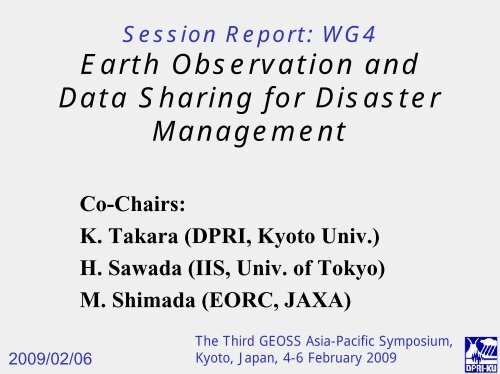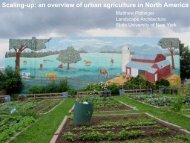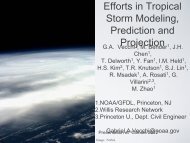Earth Observation and Data Sharing for Disaster Management
Earth Observation and Data Sharing for Disaster Management
Earth Observation and Data Sharing for Disaster Management
Create successful ePaper yourself
Turn your PDF publications into a flip-book with our unique Google optimized e-Paper software.
Session Report: WG4<strong>Earth</strong> <strong>Observation</strong> <strong>and</strong><strong>Data</strong> <strong>Sharing</strong> <strong>for</strong> <strong>Disaster</strong><strong>Management</strong>Co-Chairs:K. Takara (DPRI, Kyoto Univ.)H. Sawada (IIS, Univ. of Tokyo)M. Shimada (EORC, JAXA)2009/02/06The Third GEOSS Asia-Pacific Symposium,Kyoto, Japan, 4-6 February 2009
Session WG4 Outline• 10 speakers (including 2 additionalpresentations from Thail<strong>and</strong> <strong>and</strong> GEOSecretariat)• Many audiences (Session Room C wasalmost full. Thank you!)• Q & A was done after each presentation.• No time <strong>for</strong> Summary Discussion• The Chair recommended participants toraise their proposals, suggestions, etc.at the afternoon sessions.
IFNet-GFASHeavy rainfall alert system <strong>and</strong> flood <strong>for</strong>ecasting systemUsing satellite-based rainfall in<strong>for</strong>mation <strong>for</strong> poorly gauged basinsTomonobu SUGIURASenior ResearcherInternational Centre <strong>for</strong> Water Hazard <strong>and</strong> Risk <strong>Management</strong> (ICHARM)
ContentsIFNet (International Flood Network)Background of development of GFASSatellite-based rainfall in<strong>for</strong>mationGFAS (Global Flood Alert System)Heavy rainfall alert system using satellite-based rainfall in<strong>for</strong>mationIFAS (Integrated Flood Analysis System)Flood <strong>for</strong>ecasting system using satellite-based rainfall in<strong>for</strong>mation
JAXA’s Contribution to World Class<strong>Disaster</strong> through International <strong>Data</strong> <strong>Sharing</strong>SystemThird GEOSS Asia-Pacific Symposium<strong>Data</strong> <strong>Sharing</strong> <strong>for</strong> Traverse GEOSSFebruary 5, 2009Kyoto Research ParkShoji MatsubaraJapan Aerospace Exploration Agency(JAXA)2-2-1 Ohtemachi, Chiyoda-ku, Tokyo 100-0004 Japan
3. <strong>Data</strong> <strong>Sharing</strong> ofJAXA’s <strong>Disaster</strong> in<strong>for</strong>mation system1. Domestic <strong>Disaster</strong> Response Demonstration........... Encouraging space technology to Japanesegovernment disaster response system2. Regional <strong>Disaster</strong> In<strong>for</strong>mation <strong>Sharing</strong> System(Sentinel Asia)............. Bridging space <strong>and</strong> disastermanagement organizations in the Asian-Pacificregion3. Global <strong>Disaster</strong> In<strong>for</strong>mation <strong>Sharing</strong> Systems(The International Charter “Space <strong>and</strong> Major <strong>Disaster</strong>”)...... Cooperation among space agencies <strong>and</strong> nationaldisaster management organizations
Charter Member AgenciesCSACanadaNOAAUSGSUSACNESFranceESADMCEuropeCNSAChinaISROIndiaJAXAJapanCONAEArgentina
Charter Activation CasesLena River, RussiaBritishColumbia, CanadaGermany 1,2&3 Czeck Republic 1&2LuxembourgNorth Ossetia, RussiaNorthern France Austria 1&2Saône, & Rhône FranceSloveniaCaucassus, RussiaEnglish Channel 1&2France Lago Maggiore, ITSwitzerl<strong>and</strong>Romania 1,2&3Galicia, SpainHungaryBulgariaPortugal Etna, IT Stromboli, ITUSATehran, Iran3North KoreaBingol, TurkeyMorocco Algeria 1&2Hindu Kush, Afghanistan 1&2Al Hoceïma, MoroccoLebanon 1&2Louisiana, USAKashmir, PakistanCanary Isl<strong>and</strong>s, SpainIran 1,2&4 Kashmir, India NepalFlorida, USA Gonaives, HaitiYucatan, MexicoPakistan 1&2Assam, IndiaChinaGujarat, IndiaIndiaDominican RepublicManitoba,CanadaEl Salvador 1&2Central AmericaGuar<strong>and</strong>a Municipe, ColombiaGaleras Volcano, ColombiaGalapagos, EcuadorRarotonga, Cook Isl<strong>and</strong>s(During 2000 – 2007)BritishColumbia, CanadaHispaniola,Haiti<strong>Earth</strong>quake (17)Volcanic Eruption (8)L<strong>and</strong>slide (6)Flood/ocean wave (60)Storm/hurricane (11)Oil Spill (10)Forest Fire (8)Other (1) (Total 121)BoliviaSoufrière, MontserratGrenada Isl<strong>and</strong>SurinameGeorgetown, GuyanaVenezuelaBolivia 2Bolivia-Paraguay-ArgentinaArgentina 4Santa Fe, Argentina 1Argentina 3Patagonia, Argentina 2DenmarkSwedenSudan 1&2Ethiopia 1Ethiopia 2&3SomaliaNyiragongo, CongoKenya 1&2ComorosCaprivi,NamibiaMozambiqueGulf of Aden, YemenPhilippines 2&5Cuddalore, IndiaPhilippines 1&3Philippines 4B<strong>and</strong>a Aceh, IndonesiaSri Lanka 1&2Nias Isl<strong>and</strong>, IndonesiaJava, Indonesia 3&4Indonesia 5Nabire,Indonesia
<strong>Earth</strong> <strong>Observation</strong> <strong>and</strong> <strong>Data</strong> <strong>Sharing</strong><strong>for</strong> <strong>Disaster</strong> <strong>Management</strong> FireHaruoSawadaThe University of TokyoN THE GROUND
Forest Fire is a Worldwide <strong>and</strong> International ProblemFactorsSocial factor, Natural factorImpactsTo environment & human healthTo <strong>for</strong>est resourcesCountermeasuresPolicy, In<strong>for</strong>mation, Citizen participationNatural ScienceSocial ScienceIn<strong>for</strong>maticsVietnamInternational cooperationFeedback into policiesOperationalDetection, reportingScientificIn<strong>for</strong>mationIndonesiaAutomatic Web In<strong>for</strong>mation
Activities Related to Forest FireBe<strong>for</strong>e FireAfter FireNaturalConditionEnvironmentMonitoringEarly WarningFire RiskFire HistoryCO2 EmissionEnv. StudyHuman HealthForestEnvironmentFireSpreadForest GrowthRegenerationHumanActivityFireResistantForestFire ControlFire ConstraintEarlyDetectionSuppressionDamageAssessment<strong>Management</strong>PlantationEducation, Capacity Building
Early warningIn<strong>for</strong>mation of El Nino/La Nina <strong>and</strong> Dipole mode:Early warning <strong>for</strong> severe dry seasonby monitoring sea surface temperature (SST)Surface temperature of the world: cloud-free image of every 10 days (Sawada)
Early warningPrediction of vegetation dryness<strong>for</strong> the fire spread risk.1) Cloud-free image is created every 8 days by applying the LMF-KFfiltering to MODIS data2) Dryness Index image (VDI) is created <strong>and</strong> predicted by NDVI <strong>and</strong> NDIIExample of the effect ofLMF ProcessingPrediction of dryness2009.2.2- 2.9
Application of <strong>Earth</strong> <strong>Observation</strong>in Flood Risk Reduction in NepalM<strong>and</strong>ira Shrestha, Basanta Shrestha <strong>and</strong> SagarBajracharyamshrestha@icimodicimod.org3 rd GEOSS Asia Pacific SymposiumFebruary 4-6, Kyoto, JapanInternational Centre <strong>for</strong> Integrated Mountain DevelopmentKathm<strong>and</strong>u, Nepal
Key Issues• Transboundary rivers• Not adequate lead time• Diversity of technical,scientific <strong>and</strong> institutionalknow-how• Lack of exchange of timelyreal time data especiallyacross national boundaries• Scarce density of hydrometstations
Satellite Based Rainfall Estimation:NOAA CPC-RFE2.0• Initial version became operational in January 2001• Originally run over the African continent then exp<strong>and</strong>ed tosouthern Asia <strong>and</strong> western Asia / eastern Europe• Product is a combination of surface<strong>and</strong> satellite precipitation in<strong>for</strong>mation• Spatial resolution: 0.1 degreeTemporal resolution: daily• 5 o to 40 o N, 60 o to 110 o E15-17 Nov, 2008 SOHAM Conference
Terrain AnalysisDerivatives of the DEM <strong>Data</strong>Derived by GIS-basedTerrain AnalysisFlowDirectionFlowAccumulationFlowLengthHillLengthSlopeSource: USGS15-17 Nov, 2008 SOHAM ConferenceSubbasins<strong>and</strong> RiversSubbasinConnectivity
Monitoring of Glaciers <strong>and</strong>Glacier lake: ImjaCORONA 15 DEC 1962 SPACE SHUTTLE DEC 1983LANDSAT TM 1992IRS ID PAN 19 MAR 2001ENVISAT, ASAR, 18 October 200715-17 Nov, 2008 SOHAM ConferenceQuickbird Jan 2006 IRS LISS3 2005
<strong>Disaster</strong> monitoring using the PALSARinterferometryM. ShimadaJAXA/EORCFeb. 5 2009Kyoto Research Park
Differential SAR interferometry (2/2)Final result (3) is gained by ortho-rectification <strong>and</strong> the geocoding of the image (2)(1)orbit correction(2)topography correction(3)final result
PALSAR <strong>Data</strong> acquisitions(1/2)1,000,000 scenes
Large scale de<strong>for</strong>mation caused by the Wenchuan <strong>Earth</strong>quake
SE products (3): 2008 summer:Gamma-naughtBunkleSIMEULUE Is.Solomon
PALSAR InterferometryOrbital AccuraciesOrbital CharacteristicsInSAR combinationsIncidence angle dependenceTime dependence
Contribution of ALOS/PALSAR to the<strong>Earth</strong>quake Hazard Mitigation:Example from the 2008 Wenchuan,China, <strong>Earth</strong>quakeManabu Hashimoto, Yo Fukushima,Mari Enomoto, Mika ArimotoDPRI, Kyoto University
Precise Evaluation ofSeismic HazardPurpose of InSAR Study of<strong>Earth</strong>quakePrecise <strong>Observation</strong> ofCrustal De<strong>for</strong>mationPreciseModel
Path of ALOS Ascending orbits Look direction:EWE Off-nadir: 34.3 7~8 frames/path Swath width~70km Precise state vector(except 477) DEM: Hole-filledSeamless SRTM3by CGAIRAftershock datafrom USGS(2008)
(c)JAXA, METI, analyzed by DPRI-KU
Time SeriesAnalysis Spatialdistribution ofsecular slowfault motion Stuck patch offault Basis of strongground motioncomputation/hazard evaluationLanari et al.(2006)
ALOS/PALSARInterferogramin Shikoku(2006~2008)
Interferometric analysis of geohazardswith synthetic aperture radars :L<strong>and</strong>slidesNicola Casagli (Florence Univ., Italy; ICL)Hiroshi Fukuoka (DPRI-Kyoto Univ., Japan; ICL)
Persistent Scatterers Interferometry (PSI)pixel by pixel analysisSan FranciscoInternational Airportmulti-imageprocessingESA - ERSSanFranciscoBayProcessing technique ofSAR images <strong>for</strong>measurement of groundde<strong>for</strong>mations withmillimetric accuracy35giorni100 Km<strong>Data</strong>set of SAR images100 Kmtempo
Revised hazard area with PS in<strong>for</strong>mation
Ground based SAR interferometryPortable SAR apparatus known as LISA (Linear SyntheticAperture Radar), developed by the Joint Research Centreof the European Commission
L<strong>and</strong>slide Monitoring by Ground-based Interferometry SAR (Monte Benil<strong>and</strong>slide, Italy)08/05/2002 09/05/2002 10/05/2002 11/05/2002 12/05/2002 13/05/2002 13:59 17:10 20.28 23:37 00:07 04:00 06:35 08:4014:05 16:50 19:20 23:55 03:10 05:50 09:45 11:52 13:50 16:4519:00 21:20 23:42 02:45 06:00 08:30 11:20 14:30 17:35 20:10 22:40 02:15 05:46 08:5512:40 15:40 18:12LOS DISPLACEMENT (mm)Start: 8/5/2002 13:59End: 13/5/2002 18:12Interval: 124 hAcquisition time: 40 minPeak velocity: 0.48 mm/hMean Velocity: 0.16 mm/h
L<strong>and</strong>slide risk evaluation in Machu Picchu WorldHeritage, Peru
Analysis of DInSAR of Zentoku L<strong>and</strong>slideanalyzed by Dr. Furuta, RESETC0828 1013Time series of DInSAR Result0716 0831 1016Az2006200720080718(a)(b) (c) (d)(e)(f)Rg(a) (b) (c)(d)(e)(f)NAll of image ©METI, JAXA analyzed by RESTEC
Be<strong>for</strong>e EQ.After EQ.Detection of a l<strong>and</strong>slide dam by ALOS-PALSAR<strong>Data</strong> : JAXA EORC
Concept of Sentinel Asia<strong>and</strong> its latest activitiesThe 3 rd GEOSS Asia-Pacific Symposium in Kyoto, Japan5 February 2009Japan Aerospace Exploration AgencyKazuya Kaku42
Framework of Sentinel Asia Step2Space CommunityAPRSAF*<strong>Data</strong> ProvisionPromotion of UtilizationCapacity BuildingSentinel Asia<strong>Disaster</strong> <strong>Management</strong>CommunityADRC**Member CountriesUtilization (User)* Asian-PacificRegionalSpace Agency ForumJoint Project Team (JPT)Join Project Team consists of total 59 organizationsincluding 51 agencies from 20 countries <strong>and</strong> 8international organizations as of January 2009** Asian <strong>Disaster</strong>Reduction CenterInternational CommunityUN / ESCAP UN / OOSAASEAN AIT etc.International Cooperation43
ADRC Member Countries27 Member Countries, 5 Advisor Countries, 1 ObserverImplement Various Projects in cooperation with UN/ISDR, UN/OCHA, UNESCO, UNU, WMO, UN/ESCAP, etc.44
Flow of Emergency <strong>Observation</strong><strong>Disaster</strong>OccurrenceSupportJAXAAsia Branch(Bangkok)ADRC MembersJPT MembersADRCEmergency <strong>Observation</strong>RequestSupportDigital Camera ImagesSatellite Images& <strong>Disaster</strong> In<strong>for</strong>mation<strong>Disaster</strong> <strong>Management</strong> Agenciesin Asian CountriesFeedback<strong>Disaster</strong> In<strong>for</strong>mationSentinel AsiaSystemEmergency <strong>Observation</strong>RequestArchive ImagesJAXAISROGISTDAKARIImages by Emergency<strong>Observation</strong>Analyzed Products<strong>Data</strong> Provider NodeAITADRCCRISPAnalyzable <strong>Data</strong><strong>Data</strong> Analysis Node45
Emergency <strong>Observation</strong> in Sentinel AsiaNumber Time Place Type of disaster1 Feb. 2007 Jakarta, Indonesia Flood2 March 2007 West Sumatra <strong>Earth</strong>quake3 April 2007 Solomon Isl<strong>and</strong>s <strong>Earth</strong>quake4 May 2007 Nepal Snowstorm5 June 2007 Bangladesh L<strong>and</strong>slide6 July 2007 Pakistan Tropical Cyclone7 July 2007 Indonesia Volcano Eruption8 July 2007 Tajikistan <strong>Earth</strong>quake/L<strong>and</strong>slide9 July 2007 Indonesia Flood/L<strong>and</strong>slide10 July 2007 Bangladesh Flood11 Sep. 2007 Indonesia <strong>Earth</strong>quake12 Sep. 2007 Thail<strong>and</strong> Flood13 Oct. 2007 Vietnam Flash Flood/Flood14 Nov. 2007 Vietnam Flash Flood/Flood15 Nov. 2007 Bangladesh Tropical Cyclone16 Jan. 2008 Australia Flood17 Feb. 2008 Indonesia Flood46
Emergency <strong>Observation</strong> in Sentinel AsiaNumber Time Place Type of disaster18 May 2008 Myanmar Cyclone/Flood19 May 2008 China <strong>Earth</strong>quake20 June 2008 Indonesia Storm Surge21 June 2008 Japan <strong>Earth</strong>quake22 June 2008 Philippines Typhoon/Flood23 July 2008 Japan <strong>Earth</strong>quake24 Aug. 2008 Lao PDR Flood25 Aug. 2008 Nepal Flood26 Sep. 2008 Thail<strong>and</strong> Flood27 Sep. 2008 Nepal Flood28 Oct. 2008 Pakistan <strong>Earth</strong>quake29 Nov. 2008 Vietnam Flash Flood30 Nov. 2008 Thail<strong>and</strong> Flood31 Dec. 2008 Thail<strong>and</strong> Flash Flood32 Jan. 2009 Indonesia <strong>Earth</strong>quake/Tsunami33 Jan. 2009 Philippines Flood47
Heavy Rainfallin Hanoi, Vietnamon 30-31 October2008
ALOS/AVNIR2 <strong>and</strong> PALSAR Images49
Regional Cooperation in Step2applying Integrated Flood Analysis System (IFAS)gGlobal observation of rainfallby earth observation satellitesSatellite-basednear real-timerainfall dataTopographic dataOther GIS data <strong>for</strong> runoff mode(L<strong>and</strong> use, soil, etc.)Ex.) IFNet-GFAS, NASA-3B42RT, JAXA-GSMaP<strong>Data</strong> download throughInternet, free of chargeFlooddisasterprevention &mitigationCurrent situationDespite of the needs <strong>for</strong> flood <strong>for</strong>ecasting/warning,No rainfall, GIS data, nor analytical tools Required much money & time <strong>for</strong> implementationUser can utilize advanced technology as easily<strong>and</strong> effectively <strong>and</strong> autonomously as possible 50with the sense of local ownership
Capacity Building <strong>and</strong> Human NetworkThe 3rd Sentinel Asia SystemOperation Training by JAXAin cooperation withAIT, ISRO, ADRCin September 2008The 4th Sentinel AsiaSystem Operation Trainingis plannedin Lao PDRin February 2009
Concept of Sentinel Asia Step2<strong>Observation</strong>Communication SatelliteUtilizationSpace Agency<strong>Earth</strong> <strong>Observation</strong> SatelliteTransmission<strong>Disaster</strong><strong>Management</strong>OrganizationValue-addedIn<strong>for</strong>mation<strong>Disaster</strong> In<strong>for</strong>mation@<strong>Sharing</strong> (Web)User ExpansionGovernmental LocalOrganization Governmental(ADRC members) OrganizationEnd UserHuman NetworkCapacity Building Outreach52
Sentinel Asia Milestone2006 2007 2008 2009Step 1Step 22010 2011 2012APRSAF-13APRSAF-14 APRSAF-15 APRSAF-16 APRSAF-17 APRSAF-18 APRSAF-19JPTM#1 JPTM#2 JPTM#3 JPTM#4Step 2 JPTM#1ALOSWINDSOperationSTARTEmergency <strong>Observation</strong>ALOSIRSValidationDAN Wildfire MonitoringFull Operation, Regional CooperationFlood MonitoringGFASIFASMeteorological ImageryMTSAT-1RWINDSPreparationUtilization of WINDSSystemStep 1 SystemDevelopmentStep 2 System53
The Third GEOSS Asia-Pacific SymposiumKyoto Research Park, Kyoto, Japan4 - 6 Febuary 2009Mr. Kriengkrai KhovadhanaExpertThail<strong>and</strong> National <strong>Disaster</strong> Warning Center
3Warning Phase 1-31
• Phase I, 103 towers in Southern Thail<strong>and</strong>, West Coast• Phase II, 48 towers in Southern Thail<strong>and</strong>, East Coast• Phase III, 144 towers in Central, Northern <strong>and</strong>Northeastern Thail<strong>and</strong> (2007 – 2008)
Phrae (5)Phayao (5)Chiang Rai (4)Nan (5) Loei (3) Nong Bualamphu (3)Udonthani (3)Nong Khai (3)Mae Hong Son (4)Chiang Mai (3)Khon Kaen (1)Lampang (2)Sakon Nakhon (3)Lamphun (2)Kalasin (3)Nakhon Phonom (3)Uttaradit (3)Mahasarakham (1)Sukhothai (4)Tak (4)Mukdahan (3)Phitsanulok(3)Kamphaengphet (1)Roiet (3)Phichit (2)Amnat Charoen (3)Phetchabun(5)Chaiyaphum (1)Nakhon Sawan (2)Ubon Ratchathani (3)Uthai Thani (2)Sisaket (1)Chainat (2)Nakhon Nayok (2)Surin (1)Lopburi (2)Kanchanaburi (3)Suphanburi (2)Ayutthya (2)Ratchaburi (3)Phetchaburi (3+2)Prachuab Khiri Khan (3+2)Prachinburi (2)Sakaeo (2)Chonburi (3+2)Rayong (3+2)Chanthaburi (3+2)Trat (3+2)Buriram (1)Nakhon Ratchasima(1)Ranong (5)Chumphon (3+2)Yellow triangle shows 76 warning towers installedin disaster-prone areas in Southern Thail<strong>and</strong>, westcoast <strong>for</strong> Phase IPhang Nga (18)Suratthani (3+2)Red square shows implementation plan <strong>for</strong> PhaseII to install 3 towers in each province in EasternThail<strong>and</strong> <strong>and</strong> Southern Thail<strong>and</strong>, east coastKrabi (12)Phuket (16)Trang (11)Satun (14)Nakhon Sithamarat (3+2)Phatthalung (3+2)Songkhla (3+2)Pattani (3+2)Yala (3+2)Narathiwat (3+2)Green circle shows implementation plan <strong>for</strong>Phase III to install 3 towers in each province inNorthern <strong>and</strong> Northeastern Thail<strong>and</strong>White <strong>and</strong> green spot shows disaster areas to beinstalled warning towers in Phase II <strong>and</strong> Phase III
The Mission• Co-operation of USA (NOAA) +Thail<strong>and</strong>(NDWC)• Responsible & Care <strong>for</strong> the people ofthe Indian Ocean rim• to increase capability on thetsunami warning system ofthis region• conducted during December1-5, 2006• At 9 ο N, 89 ο E• The launching ceremonywas per<strong>for</strong>med on December1, 2006• By– H.E.Nitya Pibulsonggram,Minister of Foreign Affairs ofThail<strong>and</strong>,– H.E. Ralph L. Boyce, U.S.Embassy of Thail<strong>and</strong>.
ํํํํ ํ ํํ ํ
GEO <strong>Disaster</strong>s SBA: overview ofinitiatives <strong>and</strong> priorities in 2009-2011Veronica GrassoGEO Secretariat<strong>Disaster</strong> ExpertPresented by Osamu Ochiai“Former” GEO SecretariatNow JAXA/SAPC
DISASTERSReducing loss of life <strong>and</strong> property fromnatural <strong>and</strong> human-induced disasters.GEO Activities focus on:• Providing basic Geographic Products• Ensure provision of timely <strong>and</strong> accurate in<strong>for</strong>mation• Ensure development of predictive models <strong>and</strong> decision supportsystems• Filling technical <strong>and</strong> organizational gaps, as well as continuityissuesTowards a multi-hazard multi-risk approach
<strong>Disaster</strong>s SBA: Priorities- Ensure Access <strong>for</strong> All- Develop End-to-end Services- Coordinate <strong>and</strong> Sustain Observing Systems
<strong>Disaster</strong> Tasks – GEO 2009-2011 Work PlanLEADOVERARCHING TASKS SUB-TASKSEntity carrying out theworkDI-06-09: Use of Satellites<strong>for</strong> Risk <strong>Management</strong>DI-09-01: SystematicMonitoring <strong>for</strong> GeohazardsRisk AssessmentDI-09-02: Multi-Risk<strong>Management</strong> <strong>and</strong>Regional ApplicationsDI-09-03: Warning Systems<strong>for</strong> <strong>Disaster</strong>sDI-09-01a: Vulnerability Mapping <strong>and</strong> RiskAssessmentDI-09-01b: Seismographic NetworksImprovement <strong>and</strong> CoordinationDI-09-02a: Implementation of a Multi-Risk<strong>Management</strong> ApproachDI-09-02b: Regional End-to-End <strong>Disaster</strong><strong>Management</strong> ApplicationsDI-09-03a: Tsunami Early Warning Systemof SystemsDI-09-03b: Implementation of a FireWarning System at Global LevelCanada, China,CEOS,UNOOSAChina, France,Italy, ESA,UNOSAT,WMOChina, USA,EC, FDSN, ISCFrance, WMOFranceIOC, UNOSATCanada,Porutgal, GTOS
DI-06-09: Use of Satellites <strong>for</strong> Risk <strong>Management</strong>• With reference to a multi-hazard approach, define <strong>and</strong> facilitateimplementation of a virtual constellation <strong>for</strong> risk management.The Task will include development of dedicated software tools<strong>and</strong>• The Task will also include specific activities concerningConstellation requirements definition <strong>and</strong> per<strong>for</strong>manceassessment, with the full involvement of Users• Extension of International Charter <strong>for</strong> Major <strong>Disaster</strong>s <strong>and</strong>Space‣ Application of the concept of Virtual constellation to Risk <strong>Management</strong>‣ Activities include close consultation with the International Charter on “Space<strong>and</strong> major disasters”, in order to follow its evolution <strong>and</strong> identify its role withinthe progressive coverage of all the phases of the Risk <strong>Management</strong> Cycle.ALOS <strong>and</strong> its follow-on, Sentinel Asia
DI-09-01: Systematic Monitoring to Support Geohazards RiskAssessment• a) Vulnerability Mapping <strong>and</strong> Risk Assessment (<strong>for</strong>mer DI-06-03 <strong>and</strong> DI-06-07)Major interconnected activities include: (i) retrieval, integration <strong>and</strong> systematic access to theremote sensing <strong>and</strong> in-situ data of a certain number of regional areas (“Supersites”)exposed to geological threats (initial focus will be in dramatically enhancing access to SARdata); (ii) development, testing <strong>and</strong> application of global seismic vulnerability mapping to“Supersites” areas.• b) Seismografic Networks Improvement <strong>and</strong> Coordination (<strong>for</strong>mer DI-06-02) InSAR analisys(JAXA, DPRI-KU)Facilitate improvement of capabilities <strong>for</strong> global seismographic networks such as GSN, FDSN(including regional <strong>and</strong> global components) <strong>and</strong> GNSS networks <strong>and</strong> new ocean bottomnetworks such as VENUS <strong>and</strong> NEPTUNE.Facilitate the sharing of data <strong>and</strong> event products among GEO members.Exp<strong>and</strong> <strong>and</strong> coordinate ef<strong>for</strong>ts to provide access, using GEOSS interoperability methods, to realtime<strong>and</strong> archived seismological data <strong>and</strong> products <strong>and</strong> develop a portal that will linkdistributed seismological data centers to provide seamless access to other GEOSScomponents.
DI-09-02: Implementation of Multi-Risk <strong>Management</strong> Approach<strong>and</strong> Regional Applications• a) Multi-hazard Approach Definition <strong>and</strong> Progressive Implementation(<strong>for</strong>mer DI-06-08)Promote the definition <strong>and</strong> implementation of an integrated <strong>and</strong> comprehensiveapproach to systematically address all risks <strong>and</strong> disasters phases, including riskassessment <strong>and</strong> mapping. Support ISDR in the Implementation of the HyogoFramework <strong>for</strong> action <strong>and</strong> promote the definition <strong>and</strong> implementation of a<strong>Disaster</strong>s Community of Practice (CoP)• b) Regional end-to-end disaster management applicationsDefine framework <strong>and</strong> Implement regional cross-cutting end-to-end projects(Famine <strong>and</strong> drought early warnings <strong>for</strong> Africa; multi-risk decision-support tools<strong>for</strong> Latin-Central America <strong>and</strong> Asia; <strong>and</strong> risk management <strong>for</strong> floods such asprompt implementation of flood <strong>for</strong>ecasting <strong>and</strong> analysis system <strong>for</strong> poorlygaugedriver basins under the concept of GFAS-Streamflow proposed by IFNetusing IFAS)IFNet will be presented in the session. ICIMOD, GFAS-IFAS
DI-09-03: Warning Systems <strong>for</strong> <strong>Disaster</strong>s• a) Tsunami early warning system of systems (<strong>for</strong>mer DI-06-04)Support the establishment <strong>and</strong> continuation of a multi-hazard fully operational globaltsunami <strong>and</strong> mitigation system of systems• b) Implementation of a fire warning system at global level (<strong>for</strong>mer DI-06-13)Develop a globally-coordinated warning system <strong>for</strong> fire, including improvedprediction capabilities, analysis tools, <strong>and</strong> response through sensors,in<strong>for</strong>mation products <strong>and</strong> risk assessment models.Forest Fire Application (IIS-UT)
‣ Extending Charter Access to GEO MembersIn response to GEO request <strong>for</strong> broader GEO members’access to Charter, the Charter Board unanimouslyendorsed the principle of « universal access » <strong>for</strong> allstates.GEO is working to define a strategy <strong>for</strong> providingCharter access to all GEO members (47 GEOMembers do not have an Authorized User to activatethe Charter).
‣ Extending Charter Access to GEO MembersWithin this framework, GEO strongly supports SentinelAsia request to the Charter to trigger the Charter onbehalf of its member countries.GEO will closely coordinate with Sentinel Asia <strong>and</strong>intends to support Sentinel Asia to become regionalcenter <strong>for</strong> Charter access in the region.
Session Chair’s Suggestion• Enhancement of data availability <strong>and</strong> usability <strong>for</strong>end users• Further development of technologies <strong>for</strong> disastermanagement• Capacity building <strong>and</strong> education <strong>for</strong> disastermanagement applications• More involvement of academia (universities,research institutions) to GEO <strong>and</strong> GEOSS as users<strong>and</strong> advisors• Hazard mapping application would be a commonresearch/practice target topic







